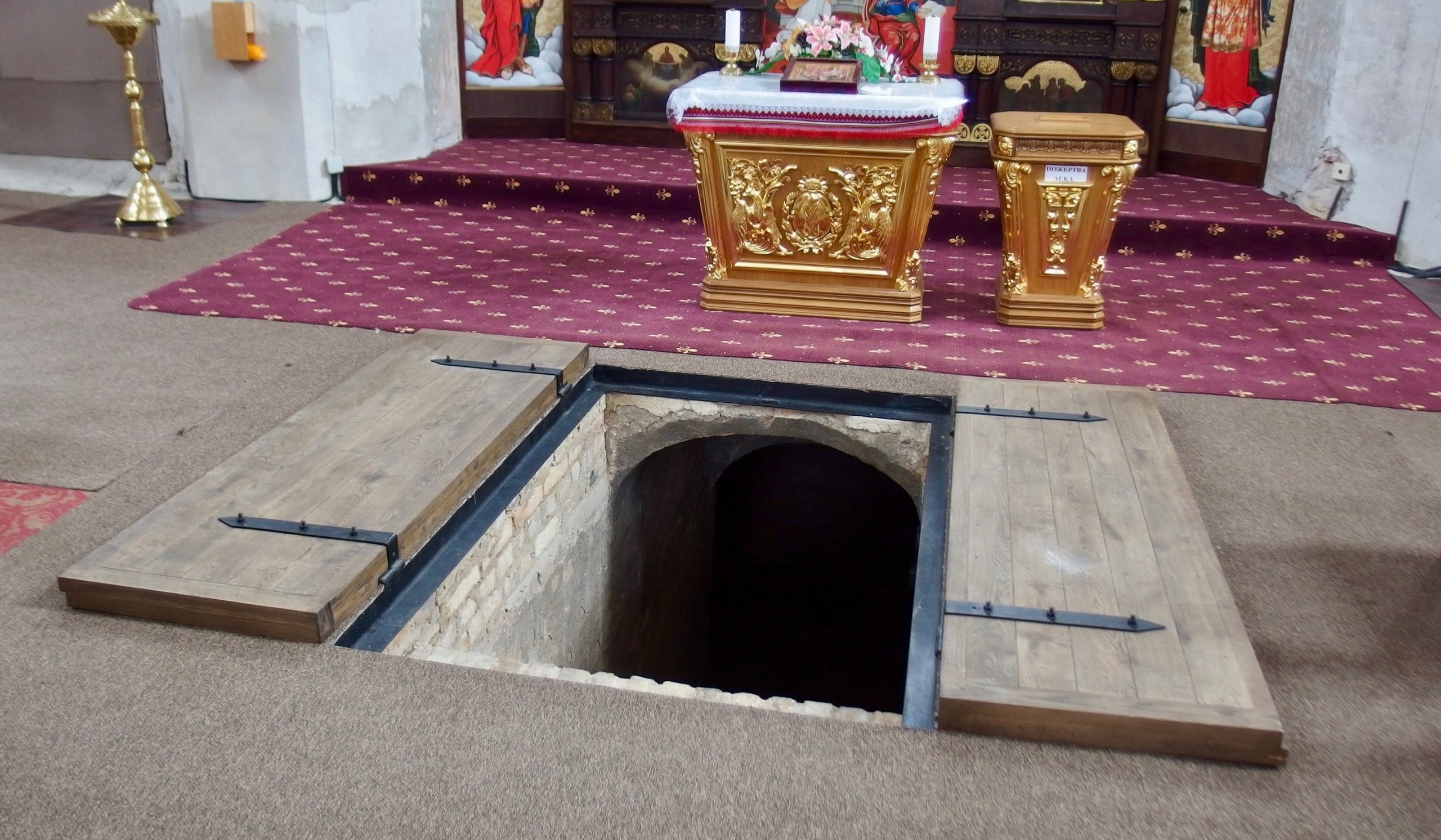In the late Middle Ages and the early Modern Period, not only the person’s position in the estate system or external signs demonstrated their social status. The place of burial also did. Monks and influential laypeople who held important offices or had other merits were buried inside churches, as close as possible to the main altar. This space was considered the holiest. Wheras less influential people were buried outside the walls of the church, in church cemeteries.
The Holy Trinity Church in Vilnius was no exception. Monks and laypeople were buried here.1Leonidas Timošenka, “Švč. Trejybės stačiatikių vienuolynas”, in: Vadimas Adadurovas, et al., Kultūrų kryžkelė: Vilniaus Švč. Trejybės šventovė ir vienuolynas, moksl. red. Alfredas Bumblauskas, Salvijus Kulevičius, Ihoris Skočiliasas, Vilnius: Vilniaus universiteto leidykla, 2017, p. 64; same: Леонід Тимошенко, “Православний монастир Св. Трійці” in: Вадим Ададуров, et al., На перехресті культур. Монастир і храм Пресвятої Трійці у Вільнюсі (series: Київське християнство, т. 16), наук. ред. Альфредас Бумблаускас, Сальвіюс Кулявічюс, Ігор Скочиляс, Львів: Український католицький університет, 2019, с. 92 This is confirmed by surviving tombstones, which demonstrate that, for instance, burgomaster Anastazy Braha (16th century) and the vicaress of the Basilian nuns Konstancja Jeleńska (18th century) were buried in the church (↑). The lateral chapels erected in the first half of the 17th century which served as burial places is a clear evidence of the mutual relationship between the nobles and the monastic community: the wojski of the Polotsk voivodeship Eustachy Korsak-Hołubicki and his wife Zofia founded the Chapel of St. Luke; the voivode of Novogrudok Teodor Skumin-Tyszkiewicz founded the Chapel of the Annunciation of the Most Holy Mother of God (which is popularly called the the Skumin Chapel); and Jan Kolęda, the court clerk of the Vilnius territorial court, founded the Chapel of the Exaltation of the True Cross (↑) (↑).2Rūta Janonienė, “Architektūrinis ansamblis”, in: Vadimas Adadurovas, op. cit., p. 212; same: Рута Янонєнє, “Архітектурний ансамбль”, in: Вадим Ададуров, op. cit., с. 314. There were burials not only in the crypts of he chapels but also in the basements located under the altars [1] (↑). This is discussed in testaments of the 17th–18th centuries. Thus, in 1666, a member of the Brotherhood of the Immaculate Conception of the Virgin Mary, the burgomaster Vilnius Jan Kukowicz, expressed a desire that his “sinful body be buried in the crypt of the brotherhood” (w sklepie Brackim).3LVIA, f. SA, b. 5335, l. 117. Other crypts with burials are mentioned in the monastery’s diary. For example, in 1778, two days after his death, the burgomaster of Vilnius Konrad Żyłko was ceremonially buried in the crypt of the church near the altar of the Blessed Josaphat, with the participation of monastic orders, Basilians, Carmelites from the Monastery of All Saints, the Bernardines, Franciscans and Dominicans.4Ibid., f. 1178, ap. 1, b. 374, l. 58‒58v. That same year on 31 August it was noted: “At seven in the evening a burial procession for the noble Antonina Milewska, the eldress of Nemėžis, proceeded to our church, and the honored priest himself, the superior [of the monastery] conducted this mourning ceremony, and that day, as people came out of the church, she was buried in the crypt under the St. Onuphrius [altar] […].”5Ibid., l. 62v. The ceremonial rites and the place of eternal rest indicate not only the person’s position in society but also close relations with the Basilians or brotherhoods that operated at the church. On the other hand, the fact that people of high social status were buried in the very church of the Holy Trinity speaks of the significance and prestige of this place (↑) (↑) (↑) (↑).
Martynas Jakulis
Išnašos:
| 1. | ↑ | Leonidas Timošenka, “Švč. Trejybės stačiatikių vienuolynas”, in: Vadimas Adadurovas, et al., Kultūrų kryžkelė: Vilniaus Švč. Trejybės šventovė ir vienuolynas, moksl. red. Alfredas Bumblauskas, Salvijus Kulevičius, Ihoris Skočiliasas, Vilnius: Vilniaus universiteto leidykla, 2017, p. 64; same: Леонід Тимошенко, “Православний монастир Св. Трійці” in: Вадим Ададуров, et al., На перехресті культур. Монастир і храм Пресвятої Трійці у Вільнюсі (series: Київське християнство, т. 16), наук. ред. Альфредас Бумблаускас, Сальвіюс Кулявічюс, Ігор Скочиляс, Львів: Український католицький університет, 2019, с. 92 |
|---|---|---|
| 2. | ↑ | Rūta Janonienė, “Architektūrinis ansamblis”, in: Vadimas Adadurovas, op. cit., p. 212; same: Рута Янонєнє, “Архітектурний ансамбль”, in: Вадим Ададуров, op. cit., с. 314. |
| 3. | ↑ | LVIA, f. SA, b. 5335, l. 117. |
| 4. | ↑ | Ibid., f. 1178, ap. 1, b. 374, l. 58‒58v. |
| 5. | ↑ | Ibid., l. 62v. |
Sources of illustrations:
| 1. | Private collection of Salvijus Kulevičius. |



